Themed collection Natural and artificial metalloenzymes

Poster list
Faraday Discuss., 2022,234, 405-405
https://doi.org/10.1039/D2FD90016E
List of participants
Faraday Discuss., 2022,234, 406-407
https://doi.org/10.1039/D2FD90017C
Concluding remarks: discussion on natural and artificial enzymes including synthetic models
This paper overviews the final remarks lecture delivered (by K. D. K.) at the end of this bioinorganic chemistry Faraday Discussion, held online for a worldwide audience from January 31 – February 3, 2022.
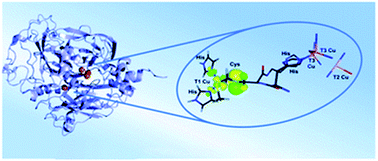
Faraday Discuss., 2022,234, 388-404
https://doi.org/10.1039/D2FD00073C
Electrocatalytic alcohol oxidation by a molecular iron complex
An efficient electrochemical method for the selective oxidation of alcohols to their corresponding aldehydes/ketones using a biomimetic iron complex, [(bTAML)FeIII–OH2]−, as the redox mediator in an undivided electrochemical cell with inexpensive carbon and nickel electrodes using water as an oxygen source is reported.

Faraday Discuss., 2022,234, 42-57
https://doi.org/10.1039/D1FD00074H
Density functional theory investigation of Ru(II) and Os(II) asymmetric transfer hydrogenation catalysts
Density functional theory calculations reveal subtle differences between the mechanism of asymmetric transfer hydrogenation of a ketone by half-sandwich Ru(II) and Os(II) arene catalysts with 5 chiral centres with formate as the hydride source.

Faraday Discuss., 2022,234, 264-283
https://doi.org/10.1039/D1FD00075F
Phenolate-bonded bis(μ-oxido)-bis-copper(III) intermediates: hydroxylation and dehalogenation reactivities
A Cu(III) intermediate, ADBPD, effects novel dehalogenation–hydroxylations of exogenous phenolates; it is best formulated as containing 2 phenolates/Cu2O2 core.
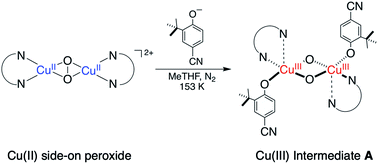
Faraday Discuss., 2022,234, 86-108
https://doi.org/10.1039/D1FD00071C
Binding of the substrate analog methanol in the oxygen-evolving complex of photosystem II in the D1-N87A genetic variant of cyanobacteria
Two-dimensional 13C HYSCORE spectroscopy, in conjunction with QM/MM and DFT, indicates that methanol binds to the Mn4Ca-oxo cluster in the S2 state of D1-N87A photosystem II from Synechocystis sp. PCC 6803.
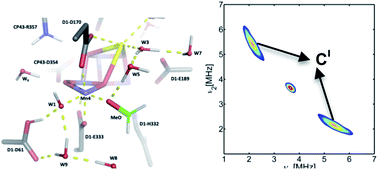
Faraday Discuss., 2022,234, 195-213
https://doi.org/10.1039/D1FD00094B
Spiers Memorial Lecture: activating metal sites for biological electron transfer
The unique spectroscopic features of metalloenzymes reflect novel geometric and electronic structures imposed by the protein activating the metal sites for efficient biological function.
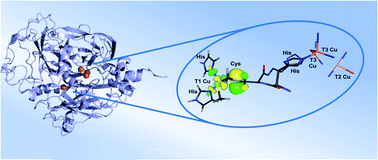
Faraday Discuss., 2022,234, 9-30
https://doi.org/10.1039/D2FD00001F
Enzymatic X-ray absorption spectroelectrochemistry
X-ray absorption spectroelectrochemistry has the potential to provide insight into enzyme mechanisms. However, protein loading on the electrode surface must be optimized and controls in place to differentiate electrochemically driven changes from beam induced damage.
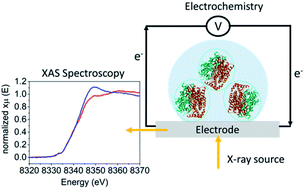
Faraday Discuss., 2022,234, 214-231
https://doi.org/10.1039/D1FD00079A
A GPx-mimetic copper vanadate nanozyme mediates the release of nitric oxide from S-nitrosothiols
In this paper, we discuss for the first time that copper vanadate (CuV2O6) can not only release NO from S-nitrosothiols but can also control ROS levels by functionally mimicking the antioxidant enzyme glutathione peroxidase at physiological pH..
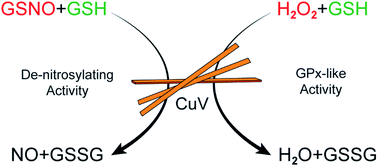
Faraday Discuss., 2022,234, 284-303
https://doi.org/10.1039/D1FD00067E
A bio-inspired heterodinuclear hydrogenase CoFe complex
The performance for H2 production of a bio-inspired CoFe complex was evaluated and compared to its two efficient FeFe and NiFe analogs. Unexpectedly, it did not show any electrocatalytic activity for H2 production.
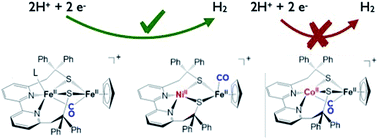
Faraday Discuss., 2022,234, 34-41
https://doi.org/10.1039/D1FD00085C
Successes and challenges in multiscale modelling of artificial metalloenzymes: the case study of POP-Rh2 cyclopropanase
We here demonstrate the interest of incorporating substrate diffusion tools in multiscale modelling of artificial metalloenzymes.
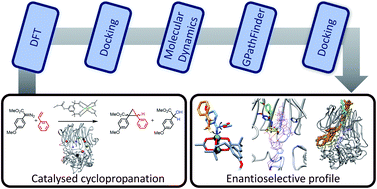
Faraday Discuss., 2022,234, 349-366
https://doi.org/10.1039/D1FD00069A
Can you break the oxo-wall? A multiconfigurational perspective
Ab initio CASSCF/NEVPT2 calculations were utilised to offer a multiconfigurational perspective on the high-valent metal–oxo species that exist beyond the oxo-wall.

Faraday Discuss., 2022,234, 175-194
https://doi.org/10.1039/D1FD00072A
Intermediate-spin iron(IV)-oxido species with record reactivity
The iron(IV)-oxido-chlorido complex shown has an S = 1 ground state and is the most reactive nonheme iron oxidant. It is shown that the reactivity relates to the energy of the dx2−y2 orbital and therefore to the ligand field strength of the co-ligand.
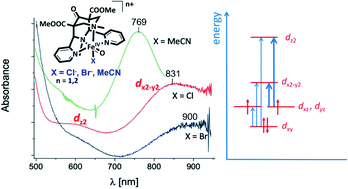
Faraday Discuss., 2022,234, 232-244
https://doi.org/10.1039/D1FD00073J
O2 reduction by iron porphyrins with electron withdrawing groups: to scale or not to scale
Iron porphyrins are synthesized by systematically introducing electron withdrawing groups (EWGs) on pyrroles to evaluate the relationship between rate (k) and overpotential (η).

Faraday Discuss., 2022,234, 143-158
https://doi.org/10.1039/D1FD00076D
Explorations of the nonheme high-valent iron-oxo landscape: crystal structure of a synthetic complex with an [FeIV2(μ-O)2] diamond core relevant to the chemistry of sMMOH
A synthetic mimic for the putative FeIV2O2 diamond core of sMMOH-Q.
![Graphical abstract: Explorations of the nonheme high-valent iron-oxo landscape: crystal structure of a synthetic complex with an [FeIV2(μ-O)2] diamond core relevant to the chemistry of sMMOH](/en/Image/Get?imageInfo.ImageType=GA&imageInfo.ImageIdentifier.ManuscriptID=D1FD00066G&imageInfo.ImageIdentifier.Year=2022)
Faraday Discuss., 2022,234, 109-128
https://doi.org/10.1039/D1FD00066G
Comparative analysis of lanthanide excited state quenching by electronic energy and electron transfer processes
Mechanistic pathways in sensitised lanthanide luminescence.
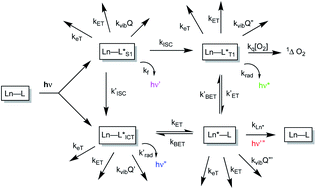
Faraday Discuss., 2022,234, 159-174
https://doi.org/10.1039/D1FD00059D
Mapping the protonation states of the histidine brace in an AA10 lytic polysaccharide monooxygenase using CW-EPR spectroscopy and DFT calculations
Using a combination of CW-EPR X-band spectroscopy and DFT calculations, we show that the active site of a chitin-active AA10 lytic polysaccharide monooxygenase can exist in three different protonation states, representing the ionisation of the coordinating groups.

Faraday Discuss., 2022,234, 336-348
https://doi.org/10.1039/D1FD00068C
Computationally driven design of an artificial metalloenzyme using supramolecular anchoring strategies of iridium complexes to alcohol dehydrogenase
A new artificial metalloenzyme for the transfer hydrogenation reaction of cyclic imines following a supramolecular anchoring strategy of the Ir-based metal catalyst to a natural alcohol hydrogenase supported by computational modelling from the start.
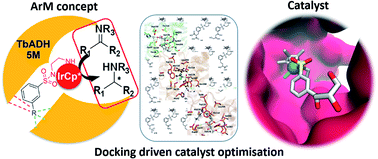
Faraday Discuss., 2022,234, 315-335
https://doi.org/10.1039/D1FD00070E
Exploring hitherto uninvestigated reactions of the fatty acid peroxygenase CYP152A1: catalase reaction and Compound I formation
We have found that CYP152A1 possesses catalase activity, which competes with the hydroxylation of long-chain fatty acids, the oxidation of non-native substrates, and haem degradation.
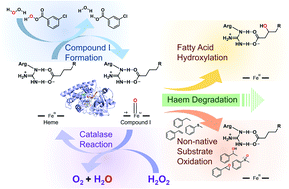
Faraday Discuss., 2022,234, 304-314
https://doi.org/10.1039/D1FD00065A
Oxidative dehalogenation of halophenols by high-valent nonheme iron(IV)-oxo intermediates
A detailed kinetics and mechanistic study on the reactivity of nonheme iron(iv)-oxo complexes for the dehalogenation reactions with halophenols reveals that the reaction proceeds via initial H-atom abstraction. The product distribution indicates that more than one reaction pathway is plausible.
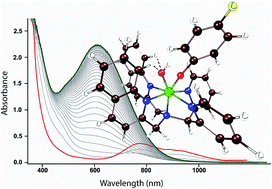
Faraday Discuss., 2022,234, 58-69
https://doi.org/10.1039/D1FD00064K
Syntheses and investigation of metal complexes with macrocyclic polythioether ligands
Copper(I) complexes with macrocyclic thioether ligands reacted with ozone to form labile “dioxygen adduct” complexes.

Faraday Discuss., 2022,234, 70-85
https://doi.org/10.1039/D1FD00062D
Small molecule activation and synthetic analogues: general discussion
Faraday Discuss., 2022,234, 129-142
https://doi.org/10.1039/D2FD90012B
Natural and artificial enzymes and medicinal aspects: general discussion
Faraday Discuss., 2022,234, 367-387
https://doi.org/10.1039/D2FD90014A
Electron transfer, spectroscopy and theory: general discussion
Faraday Discuss., 2022,234, 245-263
https://doi.org/10.1039/D2FD90013K
Introductory lecture: general discussion
Faraday Discuss., 2022,234, 31-33
https://doi.org/10.1039/D2FD90011D
About this collection
We are delighted to share with you a selection of the papers associated with a Faraday Discussion on Natural and artificial metalloenzymes. More information about the related event may be found here: http://rsc.li/metalloenzymes-fd2022. Additional articles will be added to the collection as they are published. The final versions of all the articles presented and a record of the discussions will be published after the event.
This meeting will bring together world-leaders in the field of bioinorganic chemistry, interlinked with spectroscopic and computational/theoretical physical chemists, to provide a forum to discuss current mechanistic insights into the function of many metalloenzymes, as well as small molecule activation, the synthetic analogue approach to metalloproteins/enzymes, artificial enzymes, the therapeutic use of metal-ligand complexes and the methodologies (both experimental and theoretical). The meeting will cover the 4 main themes: Small molecule activation and synthetic analogues, techniques for studies of the kinetics and thermodynamics of metal-ligand exchange reactions, electron transfer, spectroscopy and theory and the medicinal aspects of natural & artificial enzymes.
On behalf of the Scientific Committee, we hope you join us and participate in this exciting event, and that you enjoy these articles and the record of the discussion.